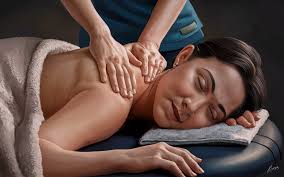The Science Behind Massage and Pain Relief

Massage therapy has been used for centuries as a natural way to alleviate pain and promote relaxation. From ancient civilizations to modern medical practices, massage has played a significant role in treating various forms of physical discomfort. But what is the science behind massage and its ability to relieve pain? Recent studies and advancements in medical science have helped to unravel the physiological and neurological processes that make massage an effective method for pain relief. This article explores the mechanisms through which massage therapy influences the body to reduce pain and promote healing.
Understanding Pain and Its Origins
Pain is a complex sensory experience that signals something is wrong within the body. It is triggered by the nervous system, particularly when nerve endings, called nociceptors, detect potential harm, such as injury or inflammation. These nerve endings send signals to the brain, which interprets them as pain. This process is vital for protecting the body from further damage, but in some cases, pain can persist even after the underlying issue is resolved, leading to chronic pain conditions. It can help manage such chronic pain by promoting relaxation and improving overall well-being.
Several factors contribute to pain, including inflammation, muscle tension, poor blood flow, and psychological stress. Massage therapy can address many of these factors, providing both immediate and long-term relief from pain.
Also Read: Massage Therpy
How Massage Relieves Pain: The Science Behind It
1. Reduction of Muscle Tension
One of the primary mechanisms through which massage relieves pain is by reducing muscle tension. Tight or overworked muscles can compress nerves and blood vessels, leading to pain and discomfort. Massage therapy works by manually manipulating the muscles and soft tissues, which helps them relax. This process not only reduces muscle tightness but also improves blood circulation, allowing more oxygen and nutrients to reach the affected area, promoting healing and reducing pain.
2. Trigger Point Release
Trigger points are areas of muscle that are tightly contracted and can cause pain either locally or in other parts of the body (referred pain). These points are often the result of muscle overuse, stress, or injury. Massage therapists are trained to identify and release these trigger points through various techniques, such as deep tissue massage or myofascial release. By applying targeted pressure to these areas, the therapist can reduce muscle contraction and alleviate the associated pain.
3. Improved Blood Flow and Lymphatic Drainage
Massage therapy increases blood circulation and improves lymphatic drainage, which are essential for pain relief. Enhanced blood flow means that more oxygen and nutrients reach damaged or inflamed tissues, accelerating the healing process. At the same time, lymphatic drainage helps remove waste products and inflammatory substances from the body. By reducing inflammation, massage therapy decreases the pain associated with swollen or injured tissues.
A 2014 study published in the Journal of Clinical and Diagnostic Research found that regular massage therapy significantly improved blood flow in patients with chronic pain conditions, leading to a reduction in pain levels and improved overall function.
4. Endorphin Release and Pain Gate Theory
One of the most fascinating aspects of massage therapy is its effect on the brain’s pain-relief mechanisms. Massage stimulates the release of endorphins, the body’s natural painkillers. Endorphins are chemicals produced by the nervous system that help reduce the perception of pain and promote a sense of well-being. A 2008 study in the International Journal of Neuroscience demonstrated that massage therapy leads to an increase in endorphin levels, which can help decrease pain intensity.
In addition to endorphins, massage therapy also works through a phenomenon known as the “gate control theory” of pain. According to this theory, the spinal cord contains a neurological “gate” that either allows or blocks pain signals from reaching the brain. Massage stimulates the large mechanoreceptors in the skin and muscles, which can “close” the gate, preventing the pain signals from being processed. This is why massage can provide immediate relief, even for chronic pain sufferers.
5. Reduction of Inflammation
Inflammation is a common cause of pain, especially in conditions such as arthritis, muscle injuries, and chronic pain syndromes. Massage therapy has been shown to reduce the production of pro-inflammatory cytokines, which are molecules that promote inflammation in the body. By reducing these cytokines, massage can decrease inflammation and, consequently, the pain associated with it.
A study published in Science Translational Medicine in 2012 found that massage therapy reduced inflammation in muscle tissues following exercise-induced muscle damage. The study concluded that massage reduced the expression of genes linked to inflammation, making it an effective treatment for muscle recovery and pain management.
6. Relaxation and Stress Reduction
Chronic pain is often exacerbated by stress and anxiety, which can lead to muscle tension, poor sleep, and heightened sensitivity to pain. Massage therapy promotes relaxation by stimulating the parasympathetic nervous system, which is responsible for “rest and digest” functions. This reduces stress hormone levels, such as cortisol, and encourages the production of feel-good neurotransmitters, like serotonin and dopamine. These effects help to alleviate pain by calming the nervous system and reducing stress-induced muscle tension.
A study in Psychological Bulletin found that massage therapy had significant positive effects on anxiety, depression, and overall mood, all of which can influence pain perception.
7. Improved Range of Motion and Flexibility
Pain is often associated with a lack of mobility and stiffness, particularly in conditions like osteoarthritis, fibromyalgia, and musculoskeletal injuries. Massage therapy helps to break down adhesions in muscles and connective tissues, improving flexibility and range of motion. By restoring mobility, massage reduces the strain on muscles and joints, alleviating the pain associated with restricted movement.
A clinical trial published in the Archives of Physical Medicine and Rehabilitation found that massage therapy improved joint mobility and reduced pain in individuals with chronic pain conditions such as osteoarthritis and fibromyalgia.
The Role of Different Massage Techniques in Pain Relief
Massage therapy encompasses a wide variety of techniques, each with its own approach to pain relief. Some of the most effective massage techniques for pain relief include:
- Swedish Massage: This is a gentle form of massage that involves long, smooth strokes to relax muscles and improve circulation. It is commonly used for general relaxation and pain relief in people with mild to moderate pain.
- Deep Tissue Massage: This technique targets the deeper layers of muscle and connective tissue, making it effective for treating chronic pain, muscle tension, and trigger points. It is often used for individuals with more severe pain conditions.
- Myofascial Release: This technique focuses on releasing tension in the fascia, the connective tissue surrounding muscles. It is particularly effective for treating chronic pain conditions such as fibromyalgia and back pain.
- Sports Massage: Sports massage is designed to address pain related to athletic injuries and muscle overuse. It combines deep tissue techniques with stretching to improve mobility and reduce pain in injured or overworked muscles.
Conclusion
The science behind massage therapy and pain relief is rooted in its ability to reduce muscle tension, improve blood flow, release endorphins, and decrease inflammation. By targeting both the physical and neurological aspects of pain, massage therapy provides a holistic approach to pain management that can be effective for a wide range of conditions. Whether you’re dealing with chronic pain, recovering from an injury, or simply looking to alleviate tension, it offers scientifically backed benefits that promote healing and long-term relief.
FAQs
1. Can massage therapy be used for chronic pain management?
Yes, massage therapy has been shown to be effective in managing chronic pain conditions such as fibromyalgia, arthritis, and back pain.
2. How often should I get a massage for pain relief?
The frequency of massage therapy sessions depends on the severity of the pain and individual needs. For chronic pain, regular sessions (weekly or biweekly) are often recommended.
3. Are there any risks associated with massage therapy for pain relief?
Massage therapy is generally safe, but it may not be suitable for individuals with certain medical conditions, such as deep vein thrombosis or severe osteoporosis. Always consult a healthcare provider before starting massage therapy.
4. What type of massage is best for muscle pain?
Deep tissue massage and sports massage are particularly effective for muscle pain, as they target the deeper layers of muscle and connective tissue.






